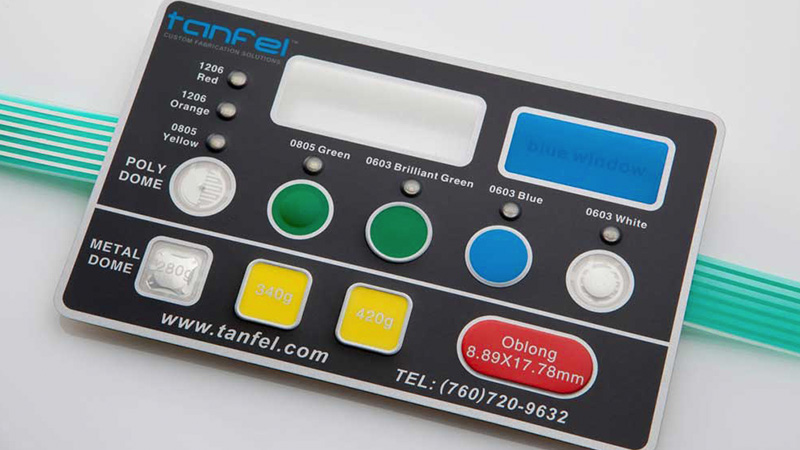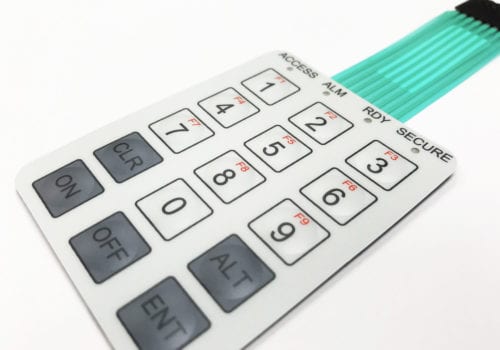The Major Benefits of Using Membrane Switches in Industrial Applications
The Major Benefits of Using Membrane Switches in Industrial Applications
Blog Article
Membrane Layer Change Innovation: The Secret to Reputable and Economical Interfaces
Membrane switch technology has become a critical component in the style of interface, providing both integrity and cost-effectiveness throughout a varied array of applications. Its durable building and construction guarantees resistance to ecological challenges, while the adaptability in style enables tailored services that fulfill specific sector requirements. As we discover the complex benefits of membrane buttons, their possibility for technology questions about future applications and developing patterns. What does the next chapter hold for this modern technology in an increasingly digital landscape?
Understanding Membrane Change Modern Technology
Membrane switch technology is a widely utilized interface remedy in various electronic devices, offering a seamless blend of performance and style. This modern technology includes numerous layers of materials, typically being composed of a visuals overlay, spacer layer, and a circuit layer. The graphic overlay presents the interface aspects, while the spacer layer separates the circuit layer from the overlay till a user turns on a button.
When pressure is applied to the overlay, the circuit layer finishes the electrical circuit, sending out a signal to the tool. This system enables different arrangements, consisting of responsive responses and backlighting alternatives, improving individual interaction. Membrane switches are typically made making use of resilient products such as polyester or polycarbonate, making sure longevity and resistance to environmental elements like moisture and dirt.
The convenience of membrane layer switches over allows their application in diverse sectors, including medical devices, customer electronics, and commercial controls. Their compact layout permits integration right into space-constrained environments, giving an effective interface without endangering aesthetic charm. Understanding the details of membrane layer switch modern technology is important for suppliers and designers looking for to develop reputable and effective human-machine interfaces.
Trick Benefits of Membrane Buttons
While various user interface solutions exist, membrane layer changes deal unique advantages that make them a favored choice in countless applications. One of the main benefits is their sturdiness; membrane layer switches are created to withstand extreme ecological problems, including moisture, dust, and temperature level changes, making certain long-lasting efficiency. This resilience substantially reduces the need for frequent replacements, consequently decreasing overall upkeep expenses.

Additionally, membrane switches are lightweight and compact, making them appropriate for applications where room is limited. Their inconspicuous style contributes to a sleek look without endangering performance.
Cost-effectiveness is additionally a notable advantage, as the manufacturing procedure for membrane layer changes tends to be cheaper compared to traditional mechanical buttons. This cost, integrated with their reliability and convenience of installation, positions membrane layer changes as a useful solution for a large range of industries seeking efficient and reliable individual interfaces.
Applications Across Numerous Industries
Exactly how do membrane buttons adjust to the varied needs of numerous markets? Membrane layer button technology is significantly recognized for its adaptability, making it ideal for a vast array of applications across multiple fields. In the medical area, membrane buttons are utilized in analysis devices and person tracking devices, where their sturdiness and ease of cleansing are crucial for keeping hygiene criteria. The automobile market uses these buttons in dashboards and control board, providing a streamlined aesthetic while making sure easy to use operation.
In customer electronic devices, membrane switches supply a portable solution for remote controls and home appliances, improving user experience with intuitive style. Additionally, the commercial field leverages membrane switches for machinery control panels, taking advantage of their resistance to extreme environments, such as moisture and dirt.
Army and aerospace applications also make use of membrane switches for their dependability and ability to endure severe problems, ensuring operational effectiveness in essential circumstances. The food and beverage industry adopts these switches for automated systems, where sanitation and ease of procedure are paramount (membrane switch). Ultimately, membrane switches are tailored to meet the unique demands of each market, verifying their crucial duty in modern-day innovation user interfaces
Style and Personalization Choices

In the world of membrane layer button technology, design and personalization alternatives play a crucial function in boosting capability and user communication. These switches can be tailored to satisfy specific functional demands and visual preferences, making them flexible elements in numerous applications.
Among the primary customization options is the layout of the switch itself, which can be developed to accommodate unique user interfaces and ergonomic considerations. By changing the form, size, and setup of buttons, makers can produce instinctive designs that assist in ease of usage. Additionally, the consolidation of different colors and graphic overlays enables for branding and enhanced presence, ensuring that individuals can quickly recognize features.
Furthermore, membrane buttons can be crafted with various responsive responses devices, such as elevated buttons or distinct clicks, to improve the customer experience. Different materials can additionally be selected for longevity and ecological resistance, resolving factors such as wetness, temperature changes, and chemical exposure.
Inevitably, the considerable layout and personalization choices available in membrane button modern technology encourage companies Visit This Link to develop customized solutions that not just satisfy functional needs however additionally align with their branding and operational needs.

Future Patterns in Membrane Buttons
As membrane layer switch technology remains to develop, future patterns are significantly concentrated on enhancing customer experience and incorporating sophisticated functionalities. One significant trend is the combination of touch-sensitive and capacitive technologies right into standard membrane layer buttons. This advancement permits even more user-friendly individual interfaces, supplying responsive feedback while preserving a smooth layout.
One more emerging fad is see page using eco-friendly products, driven by the expanding need for lasting manufacturing methods. Manufacturers are looking for to lower their carbon footprint by utilizing recyclable substratums and low-impact inks, aligning with international sustainability goals.
In addition, the rise of the Internet of Points (IoT) is prompting the unification of clever features right into membrane layer switches. Improved connection options will make it possible for gadgets to interact with each other, permitting smooth combination into more comprehensive systems.
Furthermore, advancements in printing technologies, such as digital printing, are permitting greater design flexibility and customization. This enables suppliers to produce elaborate styles and vivid colors cost-effectively.

Verdict
In conclusion, membrane switch innovation stands for a crucial innovation in user interface design, supplying substantial advantages in sturdiness, personalization, and informative post cost-effectiveness. As innovations continue to arise, specifically in touch-sensitive user interfaces and sustainable materials, the potential for membrane layer switches over to improve user experience and performance continues to be promising.
Report this page